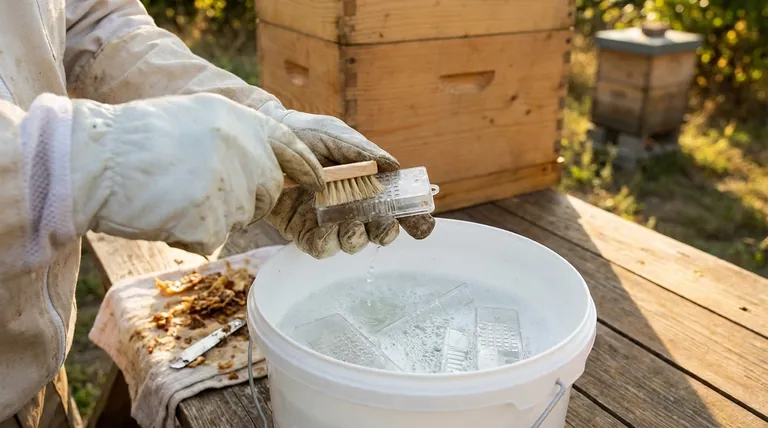Yes, queen cages are reusable, but this cost-effective practice comes with a critical responsibility. Simply reusing a cage without proper preparation can introduce significant risks to your colony. The key to safe reuse lies in meticulous cleaning and sanitization to eliminate any potential for disease transmission.
Reusing queen cages is a standard and sustainable practice for beekeepers. However, its success hinges entirely on one non-negotiable principle: you must prioritize the prevention of disease over the convenience of reuse.

The "Why" Behind Reusing Cages
Reusing equipment is common in beekeeping, and queen cages are no exception. The motivation is straightforward and practical.
Economic and Environmental Sense
Reusing cages reduces recurring costs, which can add up over time, especially for larger operations. It also minimizes plastic waste, aligning with more sustainable beekeeping practices.
The Critical Process: Cleaning and Sanitization
A visually clean cage is not enough. The invisible threats are the most dangerous. A disciplined cleaning protocol is essential to protect the health of your future queens and colonies.
Step 1: Physical Cleaning
Before disinfection, you must remove all physical debris. Scrape off any residual propolis, beeswax, and leftover candy from the cage. A small hive tool or blade works well for this task.
Step 2: Deep Sanitization
This step neutralizes pathogens. Soaking the cages in a 1:10 bleach-to-water solution is a common and effective method. Ensure the cages are fully submerged and soak for at least 20 minutes.
Step 3: Thorough Rinsing and Drying
After sanitizing, you must rinse the cages thoroughly with clean water to remove all traces of the cleaning agent. Any chemical residue could be harmful to the bees. Allow the cages to dry completely in the sun before storing or reusing them.
Understanding the Risks and Trade-offs
While reuse is beneficial, ignoring the risks can have devastating consequences for a hive. Understanding the potential downsides is key to making informed decisions.
The Primary Danger: Disease Transmission
This is the single most important consideration. A cage can act as a vector, carrying microscopic spores of diseases like American Foulbrood (AFB) or viruses from one colony to another. A cage from a hive that died out from unknown causes poses an especially high risk.
The Influence of Old Pheromones
A previous queen leaves her unique pheromones on the cage. While a thorough cleaning largely removes them, any lingering scent could theoretically interfere with the new queen's acceptance by the colony. Proper sanitization makes this a very low risk.
Considering the Colony's State
The reusability of a cage is separate from the introduction process itself. As noted, larger or more defensive colonies may require a more gradual introduction. The cage is a tool; the beekeeper's judgment about the colony's temperament remains paramount.
A Practical Guide for Your Situation
Your approach to reusing a queen cage should be dictated by the context and your tolerance for risk.
- If the cage is from a strong, healthy hive you manage: Rigorous cleaning and sanitization make it perfectly safe for reuse within your own apiary.
- If the cage is from an unknown source or another beekeeper: You must assume it could carry pathogens and follow the strictest sanitization protocol.
- If the cage came from a colony with known disease or a dead-out: The safest and most responsible action is to discard the cage. The low cost of a new cage is not worth the high risk of infecting a healthy colony.
Ultimately, adopting a strict sanitization protocol transforms queen cage reuse from a potential liability into a safe, smart, and sustainable beekeeping practice.
Summary Table:
| Key Consideration | Recommendation |
|---|---|
| Economic & Environmental Benefit | Reusing cages reduces costs and plastic waste. |
| Primary Risk | Disease transmission (e.g., American Foulbrood) is the biggest danger. |
| Critical Action | Mandatory cleaning and sanitization before every reuse. |
| When to Discard | If the cage came from a diseased colony or an unknown source with high risk. |
Ensure the health of your apiary with reliable, high-quality supplies. Proper equipment is the foundation of successful beekeeping. At HONESTBEE, we supply commercial apiaries and beekeeping equipment distributors with the durable, wholesale-focused tools they need to operate efficiently and sustainably. From queen cages to essential hive components, our products are designed to support your practice. Let's discuss your needs — contact our team today to get the right equipment for your operation.
Visual Guide

Related Products
- Professional Multi-Functional Queen Bee Cage
- Multi-Function Queen Roller Cage and Catcher
- Durable Galvanized Steel Spring Queen Bee Cage
- Professional Round Push-In Queen Cage with Metal Tines
- Professional Multi-Compartment Queen Cage with Sliding Lid
People Also Ask
- What are the components of a standard queen cage? A Guide to Safe Queen Introduction
- What should be done before removing the queen cage from the hive? Ensure Your New Queen is Accepted & Laying
- What is sequestration, and how does it help bees reorient? A Safer Guide to Hive Relocation
- How long does it typically take bees to adjust to a new queen? Master the 2-7 Day Acceptance Window
- What should be done if bees damage the queen cage or harm the queen? Rescue Your Queen and Save Your Hive



















